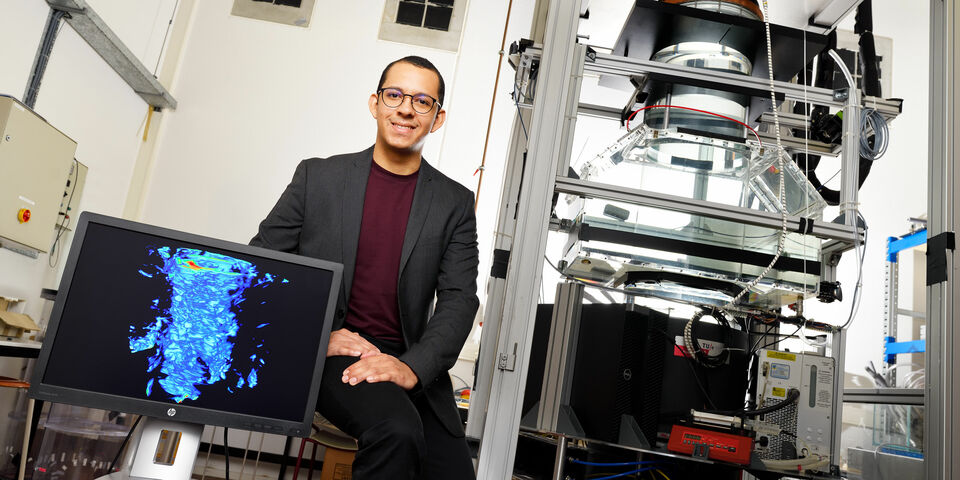Home Stretch | Whirlwind in a computer
Gaining an understanding of flows in the atmosphere, oceans and the depths of the earth is a challenging task. The Venezuelan doctoral candidate Andrés Aguirre Guzmán used an Amsterdam supercomputer and performed simulations of a four-meter tall, pillar-shaped test setup to help move his field forward.
Many large-scale flows found in nature - such as airflows in the atmosphere, ocean currents and the circulation of liquid metal beneath the earth's surface - are driven by heating and are affected by the earth's rotation. Doctoral candidate Andrés Aguirre Guzmán tells us that both climate science and our concept of the ‘terra incognita’ in the depths of the earth would benefit from our knowing more about this type of flow - known as rotating Rayleigh-Bénard convection.
Unfortunately, working on the basis of the known mathematical description of this phenomenon, it is, he says, difficult to make practical (computer) predictions - particularly if turbulence occurs and chaotic whirlwinds arise. “When calculating turbulent flows you have to work at a more detailed level, but that demands huge computational power.”
This becomes a problem particularly when the simulation concerns the major geophysical systems mentioned above, in which the primary parameters - the Rayleigh number (a measure of the influence of gravity and temperature differences) and the Ekman number (which denotes the magnitude of the influence of the rotation) - are immense and minute, respectively.
Pillar-shaped
Five years ago Aguirre Guzman's supervisor Rudie Kunnen secured a large European grant to simulate geophysical flows like these in a four-meter tall, pillar-shaped rotating cylinder in the lab of the Fluids and Flows group (Department of Applied Physics). Here, water is heated from below to 50 degrees and is cooled at the top in order to generate an upward current and enable the effect of the turning of the cylinder - used to simulate the earth's rotation - to be studied.
“Rudie took me on back then to carry out the computer simulations this involved,” the Venezuelan explains. Strikingly enough, in a physical experiment it is easier to come close to the geophysical situation than it is in a computer simulation, he points out. “Measurements are technically challenging, though. Simulations, on the other hand, give access to all physical quantities, and thus provide more detail of the flow dynamics. But in both cases, unfortunately, we are still orders of magnitude removed from the numbers that apply to the flowing liquid metal beneath the earth's crust.”
Supercomputer
However, with the help of Cartesius, the Dutch national supercomputer he did manage to come a step closer to a reliable simulation of rotating Rayleigh-Bénard convection on a planetary scale. “To achieve this, I had the supercomputer in Amsterdam carry out computations for a period totaling a number of months, in blocks of five days. This enabled me to use more extreme - and thus more realistic - parameters than had previously been used.”
Some of the phenomena to which his calculations are relevant, are how whirlwinds can develop above land, and how the much more powerful offshore cyclones can sustain their power while moving over land, thus being able to cause huge destruction in some parts of the world each year. “The topography of the Earth’s surface, such as mountains, induces vertical flows that disturb the dominant horizontal atmospheric flows. I have shown that because of those vertical disturbances, at geophysically relevant conditions, whirlwinds can develop due to the interplay between the vertical and horizontal flows. I also showed that the vertical flows can be sheared apart by the much stronger horizontal winds.”
The latter effect is one of the reasons why offshore cyclones - powered by the energy of warm sea water - won’t die out quickly when they come ashore: when they are strong enough, they will be able to overcome the mentioned disturbances caused by the Earth’s surface.


Discussion